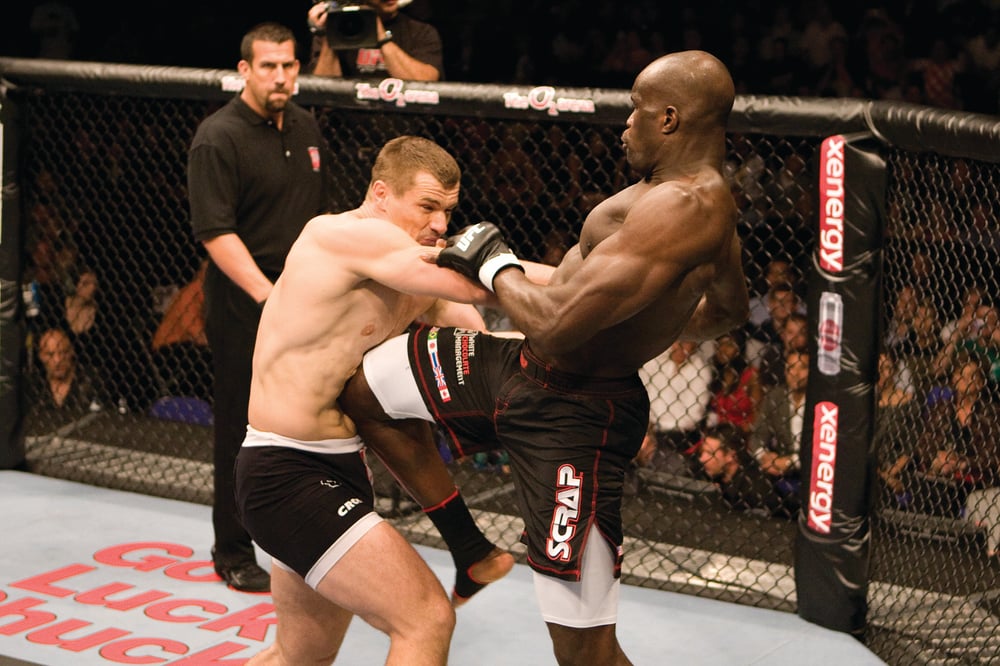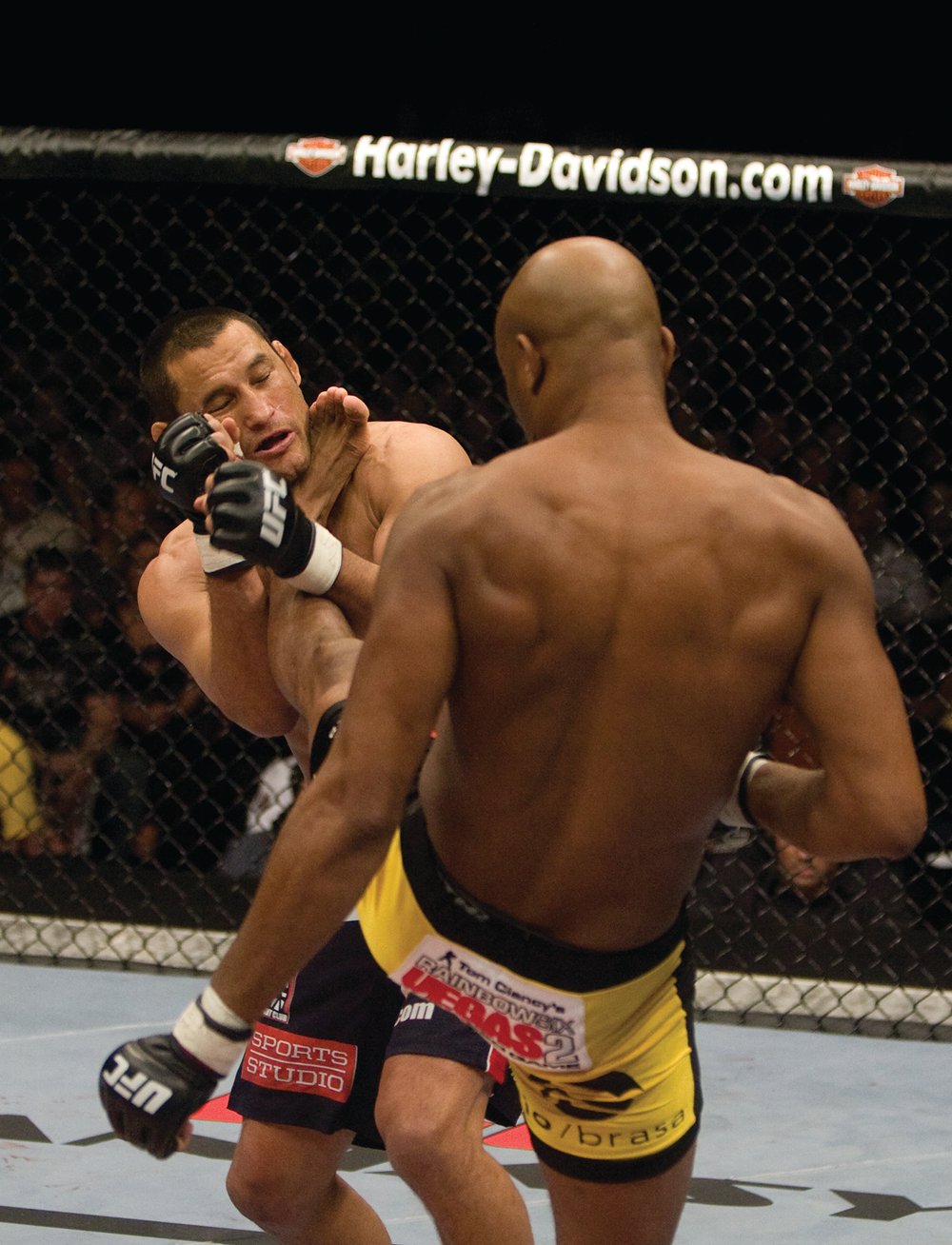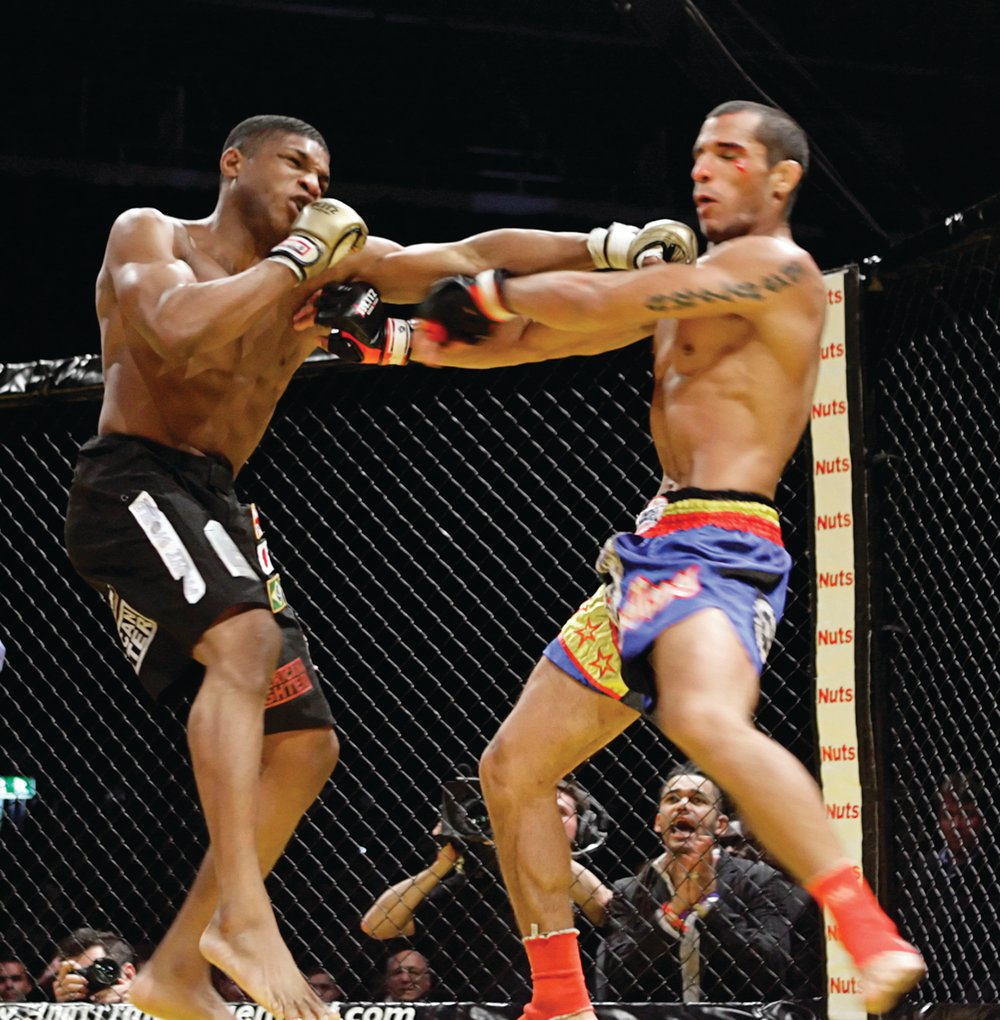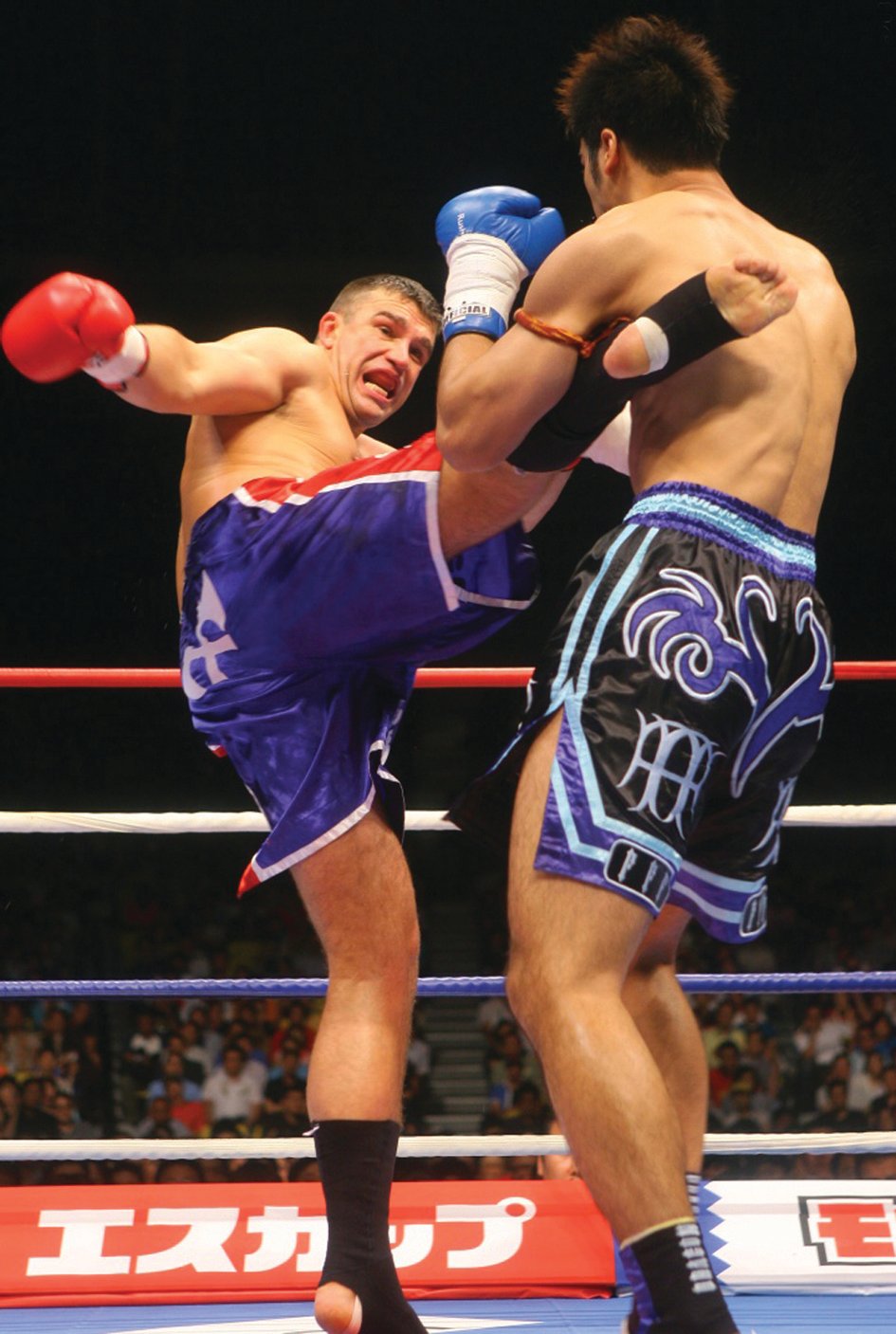
Issue 043
November 2008
The Octagon has tested many styles of stand-up throughout the years, from boxing to ninjitsu. While one would like to believe that all striking martial arts were created equal, all it takes is a viewing of an old UFC event to realise that certain styles tend to fare better than others. But which one fares the best you might ask? The answer is simple – Muay Thai.
Though it may not be as flashy as tae kwon do, or have a place in popular culture like karate, Muay Thai has proven its effectiveness in an uncountable number of MMA bouts. With a vast arsenal of simple and effective strikes, ‘The Science of Eight Limbs’ is considered an essential part of any fighter’s toolbox, along with Brazilian jiu-jitsu (BJJ), boxing and wrestling.
Originating in Thailand, Muay Thai (or Thai boxing as it’s often called) is not only the country’s national sport, it’s also taught as a form of self-defence and personal development. Thais from all walks of life study the martial art, and Thai legends are full of references to great fighters. But how did this art leave South-East Asia and find it’s way to the cage? For that we have to thank none other than the Dutch, who brought Thai boxing to the Old Continent in the early seventies.
“We brought Muay Thai to Europe,” says Ivan Hippolyte, Muay Thai trainer of Amsterdam’s legendary Vos Gym. “But it wasn’t until the mid-70’s, when trainers like Thom Harinck and Jan Plaas started to adapt the art that it became so popular. They took the best of Kyokushinkai [karate], boxing and Muay Thai, and from that they created a new style and a new system of training.”

Within ten years Thai boxing had become Holland’s second favourite sport, just behind football. Not only were Dutch fighters battling it out in galas nearly every weekend, they were also travelling to Thailand, where they were teaching local fighters a thing or two.
“Before we knew it, our guys were beating the Thais,” says Hippolyte. “We showed them how to use punches effectively, but eventually it became a two-way street, with both the Thais and Europeans pushing the art forward, making it evolve.”
When the MMA craze hit Holland in the early 90s, it wasn’t long before the rest of the world took notice of the unusual art that used knee and elbow strikes, along with devastating kicks and pinpoint accurate punches. According to European Muay Thai champion-turned-MMA-fighter, Cyrille Diabate, it was this unusual versatility that led to Muay Thai being the dominant stand-up style in MMA today.
“There are many reasons why Muay Thai is so successful in MMA,” says Diabate. “But number one is the versatility of the art – you’re taught punches, kicks, elbows and knees, which aren’t usually taught in other arts. You learn to use all your tools, and you can use all of them legally in the cage.”

However, history has proven that not all Muay Thai stylists attain success under MMA rules. In fact, some of the most highly regarded Thai boxers (including Ramon Dekkers and three-time K-1 champion Peter Aerts) have been utterly destroyed in MMA bouts, mostly due to a lack of grappling experience. While they have no problem taking their opponents standing, everything changes when the fight is taken to the mat.
“MMA is not for me,” laughs Aerts, who holds a 1-1 record in MMA. “I’ve been fighting K-1 rules for too long, and it’s just a different game on the ground. It’s hard to change. I think if one learns both Muay Thai and grappling from the beginning, he has a much better chance of being good at MMA. I still enjoy it of course, it’s fun – but it’s just not for me.”
So what’s the secret weapon of a pure Muay Thai stylist hoping to make it big in MMA? Three things: takedown defence, takedown defence and, finally, more takedown defence. But good takedown defence is more than just knowing how to sprawl – distance, pacing and the length of combinations all factor into how likely a striker is to be taken down.
“A pure Muay Thai fighter must change things about his style if he wants to succeed,” says Diabate. “It took me quite a while to get used to striking for MMA. You’re constantly in danger of being taken down, so you can’t stand up as straight, you can’t throw long combinations either. There are many, many things you must adapt, and the only way to do that is to put endless hours of training into it.”
Adapting Muay Thai for MMA may be time consuming, but the result can be devastating, as demonstrated by the top Muay Thai fighter in the UFC: Anderson Silva. In less than two years, Silva has run through the competition in the UFC middleweight division, showcasing his beautiful, and downright deadly, style. With laser-accurate strikes, and the best Thai clinch in the business, Silva has never had a UFC bout last into the third round, making him arguably the best pound-for-pound fighter in the world.
The UFC middleweight champion learnt his Muay Thai from the legendary Chute Boxe Academy in Curitiba, Brazil, a martial arts school often credited for being the first to truly adapt Muay Thai for the cage. Throughout the years, Chute Boxe has produced numerous MMA champions, including Wanderlei Silva, Mauricio ‘Shogun’ Rua, Murilo ‘Ninja’ Rua and more.
But along with world-class Thai boxing, Chute Boxe has also emphasised the importance of a good ground game.
While not a primary weapon, BJJ serves the Muay Thai stylist as a support system, to get out of tight spots and back on their feet.
“Of course it’s best for a Muay Thai based fighter to never get taken down,” says Diabate, a self-admitted fan of Anderson Silva. “But if you do, you must get up quickly, and that’s where good jiu-jitsu comes in. A Muay Thai fighter might not ever learn to be good with submissions, but he has to be able to get back to his feet. The idea is to make your opponent pay for each takedown attempt. Every time he comes in, you’ve got to punish him. Eventually you’ll land damaging shots, and hopefully end the fight.”

With more and more fighters investing in good Muay Thai training, fans are starting to see a higher level of stand-up in MMA. Years ago, techniques like flying knees and superman punches were reserved for the K-1 ring, whereas today they have found a new home in the Octagon.
Over a decade ago, Brazilian Jiu-Jitsu revolutionised the way fighters train. Today, MMA fans are seeing the next step in the revolution, as Muay Thai becomes an equally important part of a fighter’s repertoire. But has Muay Thai evolved as far as it will go? Fighters and trainers alike don’t think so.
“MMA will keep on evolving,” says Diabate. “So Muay Thai will too. Whenever we think we know everything, someone comes along and shows us we don’t.”
Hippolyte seconds Diabate’s opinion. “I think Muay Thai is perfect for MMA,” he says. “But the sport is constantly changing. If a Thai boxer doesn’t stay current, he won’t survive – it’s as simple as that.”
Scandinavia at a Glance
Sweden
The largest country in Scandinavia with the highest numbers of gyms and practitioners, Sweden is home to events such as Superior Challenge and The Zone (formerly known as European Vale Tudo). Home to some of the best grapplers in Europe.
Denmark
Though the smallest of all Scandinavian countries, Denmark has events such as Adrenaline, FighterGalla and EuroMMA. Danish fighters are known as impressive strikers.
Finland
Though they do not have as high-profile fighters as other countries, Finland has a thriving local scene with pro events such as ‘The Cage’, Shooto, Finn Fight, and regular amateur competitions.
Norway
No professional combat sports are permitted in Norway, with only amateur boxing and martial arts such as karate and grappling allowed by local laws. All Norwegian fighters must travel in order to compete in MMA.
Iceland
Only two fighters have been produced by Iceland’s sole MMA gym, Mjolnir, but both impressed on events in England and Ireland. Slim to no chance of events ever taking place due to lack of numbers and government opposition.

Top Muay Thai Stylists
Anderson ‘The Spider’ Silva
Not only is Anderson Silva universally acknowledged as the best middleweight in MMA, he’s also arguably the best striker and according to UFC President Dana White, the best pound-for-pound fighter. Whether or not you agree with the last statement there’s no denying that Silva’s Muay Thai is second to none. His punches, kicks, knees and elbows are nothing short of perfect, allowing Silva to finish a fight anyway he chooses. Over the years, The Spider has accumulated a plethora of highlight reel-worthy flying knees, kicks and even a standing inverted-elbow KO.
Mauricio ‘Shogun’ Rua
Another ex-Chute boxer. Though his Muay Thai isn’t as technically refined as Silva’s, Mauricio ‘Shogun’ Rua’s aggressive high-flying style has won him numerous fans over the years. Particularly impressive is his Thai clinch, which was instrumental in defeating the likes of Quinton Jackson, Ricardo Arona and Alistair Overeem.
Cheick Kongo
In every fight Kongo demonstrates pure, orthodox European Muay Thai at its absolute best. Not only does he flow seamlessly from knees to punches to kicks, he also packs a lot of power. Even the most seasoned veterans like Mirko ‘Cro Cop’ Filipovic avoid going toe-to-toe with this Muay Thai stylist. Unfortunately his great stand-up skills are off-set by his ground game, an area he is slowly developing.
Melvin Manhoef
Melvin Manhoef has a great philosophy when it comes to Muay Thai: “Keep it simple”. The Dutch fighter avoids flashy techniques, instead relying on short powerful combinations usually consisting of hooks, knees and low kicks. A top fighter in the DREAM middleweight division, Manhoef has yet to find an opponent capable of going toe-to-toe with him. The closest anyone came was in his bout with Evangelista ‘Cyborg’ Santos, mandatory viewing for any true MMA fan.
Paul Daley
Regarded by many as the UK’s best striker, the heavy-handed Daley has proven the effectiveness of his Muay Thai with wins over the likes of Mark Weir, Duane Ludwig, Sam Morgan, and a memorable body-shot KO over Paul Jenkins. At only twenty-five years of age he still has plenty of time to showcase his Muay Thai overseas.












